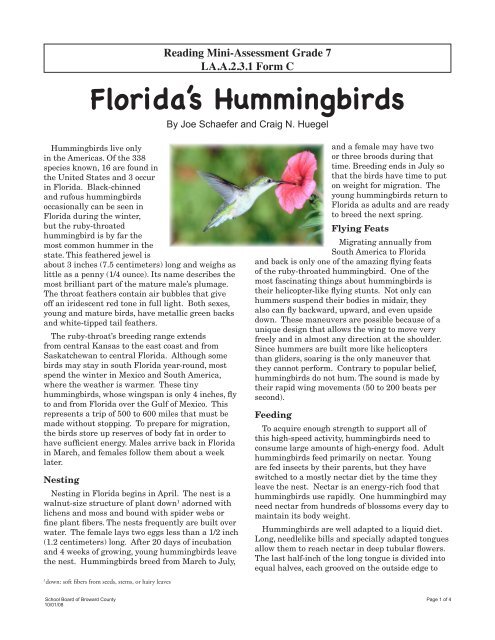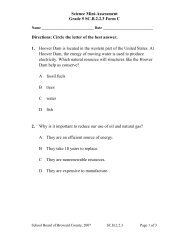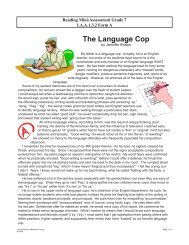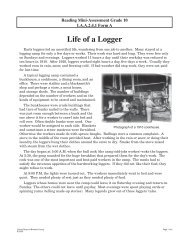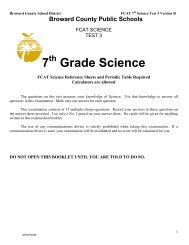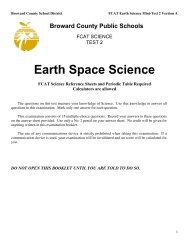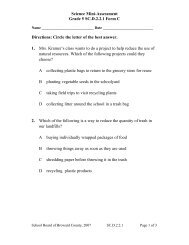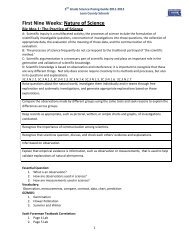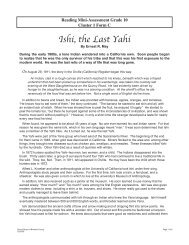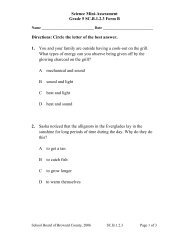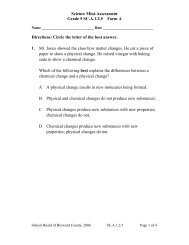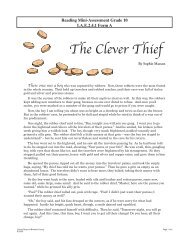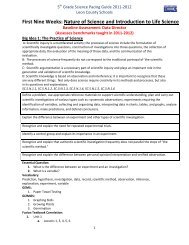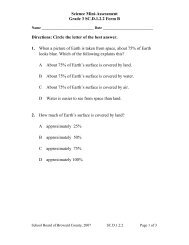Florida's Hummingbirds
Florida's Hummingbirds
Florida's Hummingbirds
You also want an ePaper? Increase the reach of your titles
YUMPU automatically turns print PDFs into web optimized ePapers that Google loves.
Reading Mini-Assessment Grade 7<br />
LA.A.2.3.1 Form C<br />
Florida’s <strong>Hummingbirds</strong><br />
By Joe Schaefer and Craig N. Huegel<br />
<strong>Hummingbirds</strong> live only<br />
in the Americas. Of the 338<br />
species known, 16 are found in<br />
the United States and 3 occur<br />
in Florida. Black-chinned<br />
and rufous hummingbirds<br />
occasionally can be seen in<br />
Florida during the winter,<br />
but the ruby-throated<br />
hummingbird is by far the<br />
most common hummer in the<br />
state. This feathered jewel is<br />
about 3 inches (7.5 centimeters) long and weighs as<br />
little as a penny (1/4 ounce). Its name describes the<br />
most brilliant part of the mature male’s plumage.<br />
The throat feathers contain air bubbles that give<br />
off an iridescent red tone in full light. Both sexes,<br />
young and mature birds, have metallic green backs<br />
and white-tipped tail feathers.<br />
The ruby-throat’s breeding range extends<br />
from central Kansas to the east coast and from<br />
Saskatchewan to central Florida. Although some<br />
birds may stay in south Florida year-round, most<br />
spend the winter in Mexico and South America,<br />
where the weather is warmer. These tiny<br />
hummingbirds, whose wingspan is only 4 inches, fly<br />
to and from Florida over the Gulf of Mexico. This<br />
represents a trip of 500 to 600 miles that must be<br />
made without stopping. To prepare for migration,<br />
the birds store up reserves of body fat in order to<br />
have sufficient energy. Males arrive back in Florida<br />
in March, and females follow them about a week<br />
later.<br />
Nesting<br />
Nesting in Florida begins in April. The nest is a<br />
walnut-size structure of plant down 1 adorned with<br />
lichens and moss and bound with spider webs or<br />
fine plant fibers. The nests frequently are built over<br />
water. The female lays two eggs less than a 1/2 inch<br />
(1.2 centimeters) long. After 20 days of incubation<br />
and 4 weeks of growing, young hummingbirds leave<br />
the nest. <strong>Hummingbirds</strong> breed from March to July,<br />
1<br />
down: soft fibers from seeds, stems, or hairy leaves<br />
and a female may have two<br />
or three broods during that<br />
time. Breeding ends in July so<br />
that the birds have time to put<br />
on weight for migration. The<br />
young hummingbirds return to<br />
Florida as adults and are ready<br />
to breed the next spring.<br />
Flying Feats<br />
Migrating annually from<br />
South America to Florida<br />
and back is only one of the amazing flying feats<br />
of the ruby-throated hummingbird. One of the<br />
most fascinating things about hummingbirds is<br />
their helicopter-like flying stunts. Not only can<br />
hummers suspend their bodies in midair, they<br />
also can fly backward, upward, and even upside<br />
down. These maneuvers are possible because of a<br />
unique design that allows the wing to move very<br />
freely and in almost any direction at the shoulder.<br />
Since hummers are built more like helicopters<br />
than gliders, soaring is the only maneuver that<br />
they cannot perform. Contrary to popular belief,<br />
hummingbirds do not hum. The sound is made by<br />
their rapid wing movements (50 to 200 beats per<br />
second).<br />
Feeding<br />
To acquire enough strength to support all of<br />
this high-speed activity, hummingbirds need to<br />
consume large amounts of high-energy food. Adult<br />
hummingbirds feed primarily on nectar. Young<br />
are fed insects by their parents, but they have<br />
switched to a mostly nectar diet by the time they<br />
leave the nest. Nectar is an energy-rich food that<br />
hummingbirds use rapidly. One hummingbird may<br />
need nectar from hundreds of blossoms every day to<br />
maintain its body weight.<br />
<strong>Hummingbirds</strong> are well adapted to a liquid diet.<br />
Long, needlelike bills and specially adapted tongues<br />
allow them to reach nectar in deep tubular flowers.<br />
The last half-inch of the long tongue is divided into<br />
equal halves, each grooved on the outside edge to<br />
School Board of Broward County Page 1 of 4<br />
10/01/08
form two tube-like structures. Nectar is drawn into<br />
the tongue much the same way liquid travels up a<br />
straw. <strong>Hummingbirds</strong> can lick at a rate of 13 times<br />
per second, and their stomach is capable of holding<br />
about 0.18 ounces (5 grams) of nectar at one time.<br />
They also feed, to a lesser extent on insects.<br />
For their size, hummingbirds have among the<br />
largest appetites in the bird world. They feed every<br />
10 or 15 minutes from dawn until dusk. During<br />
this period, they consume more than half their<br />
weight in food and 8 times their weight in water.<br />
<strong>Hummingbirds</strong> have developed two adaptations to<br />
help them survive the hours of darkness when they<br />
cannot feed. First, they eat as much as they can just<br />
before dark. During the night, their heart rate and<br />
body temperature drop to conserve energy, and they<br />
perch lifelessly on a branch. If they did not go into<br />
this sort of daily hibernation stage, they would be<br />
likely to starve.<br />
Gardening for <strong>Hummingbirds</strong><br />
To be successful in keeping hummingbirds around<br />
your house, you must garden for them. The ideal<br />
Reading Mini-Assessment Grade 7<br />
LA.A.2.3.1 Form C<br />
Tables 1 and 2 show some of the plants that are among the favorites used by hummingbirds in north and central<br />
Florida. While red flowers dominate the list, others have been added to allow for a varied planting. Plants native to<br />
Florida are preferable when given the proper growing conditions for the species.<br />
Table 1<br />
Hummingbird Plants: Perennials<br />
Common Name Adaptability to Region Blooming Season<br />
Butterfly Milkweed Native Species Spring–Fall<br />
Red Basil Native Species Spring<br />
Shrimp Plant Used as an annual in North Florida Spring–Summer<br />
Cardinal Flower Native Species Summer–Fall<br />
Obedient Plant Native Species Summer–Fall<br />
Table 2<br />
Hummingbird Plants: Annuals<br />
Common Name Adaptability to Region Blooming Season<br />
Scarlet Morning Glory Native Species Summer–Fall<br />
Cypress Vine Native Species Summer–Fall<br />
Standing Cypress Native Species Summer<br />
Four O’Clock Not recommended for South Florida Fall<br />
flower color is red, orange, or pink. <strong>Hummingbirds</strong><br />
are not born with an attraction to certain colors,<br />
but they learn by trial and error which flowers<br />
give the best results. Because most nectar-bearing<br />
flowers within the range of the ruby-throat are red<br />
and orange, they quickly come to favor those colors.<br />
<strong>Hummingbirds</strong> also have been known to show an<br />
interest in red-colored lipstick, fingernails, and<br />
clothing.<br />
Tubular flowers that are either large and solitary<br />
or in loose drooping clusters are best. Generally,<br />
tubular flowers hold large amounts of nectar at<br />
their base.<br />
Blooming season is another important gardening<br />
consideration. Nesting hummingbirds will need<br />
nectar from March to September. Therefore, your<br />
garden should have numerous nectar plants<br />
available throughout this time. It is best to plant a<br />
variety of species and to arrange these flowers in<br />
several groupings. Nesting hummingbirds are very<br />
aggressive and territorial around their food source.<br />
Having more than one flower garden will allow<br />
several hummers to feed at the same time without<br />
conflict.<br />
Copyrighted by the University of Florida, Institute of Food and Agricultural Sciences (UF/IFAS).<br />
School Board of Broward County Page 2 of 4<br />
10/01/08
Reading Mini-Assessment Grade 7<br />
LA.A.2.3.1 Form C<br />
Name __________________________________________ Date ___________________<br />
Directions: Read the article “Florida’s <strong>Hummingbirds</strong>,” then select the correct answer.<br />
1. Which new title BEST fits this article?<br />
A. “Interesting Hummingbird Facts”<br />
B. “Caring for <strong>Hummingbirds</strong>”<br />
C. “Migration Habits of <strong>Hummingbirds</strong>”<br />
D. “Hummingbird Adaptations”<br />
2. What is the primary topic of the first paragraph in the article?<br />
A. where hummingbirds nest<br />
B. why hummingbirds hum<br />
C. what hummingbirds look like<br />
D. when hummingbirds migrate<br />
3. The authors do not discuss flowers that bloom in October through February because<br />
A. gardeners rarely plant flowers in those months.<br />
B. there are few hummingbirds to see in those months.<br />
C. few nectar-producing plants bloom in those months.<br />
D. flowers that bloom in those months are the wrong color.<br />
4. The idea that hummingbirds have one of the largest appetites in the bird world is based on the fact that<br />
A. they hibernate at night so they won’t starve.<br />
B. they eat 4 – 6 times per hour when awake.<br />
C. they double their weight every day.<br />
D. they can lick nectar at a rate of 13 times per second.<br />
School Board of Broward County Page 3 of 4<br />
10/01/08
Reading Mini-Assessment Grade 7<br />
LA.A.2.3.1 Form C<br />
ANSWER KEY – Florida’s <strong>Hummingbirds</strong><br />
LA.A.2.3.1: main idea, details, how organizational pattern supports main idea<br />
1. Which new title BEST fits this article?<br />
A. “Interesting Hummingbird Facts”<br />
B. “Caring for <strong>Hummingbirds</strong>”<br />
C. “Migration Habits of <strong>Hummingbirds</strong>”<br />
D. “Hummingbird Adaptations”<br />
Item #<br />
Answer<br />
1. A<br />
2. C<br />
2. What is the primary topic of the first paragraph in the article?<br />
A. where hummingbirds nest<br />
B. why hummingbirds hum<br />
C. what hummingbirds look like<br />
D. when hummingbirds migrate<br />
3. B<br />
4. B<br />
3. The authors do not discuss flowers that bloom in October through February because<br />
A. gardeners rarely plant flowers in those months.<br />
B. there are few hummingbirds to see in those months.<br />
C. few nectar-producing plants bloom in those months.<br />
D. flowers that bloom in those months are the wrong color.<br />
4. The idea that hummingbirds have one of the largest appetites in the bird world is based on the fact that<br />
A. they hibernate at night so they won’t starve.<br />
B. they eat 4 – 6 times per hour when awake.<br />
C. they double their weight every day.<br />
D. they can lick nectar at a rate of 13 times per second.<br />
School Board of Broward County Page 4 of 4<br />
10/01/08


